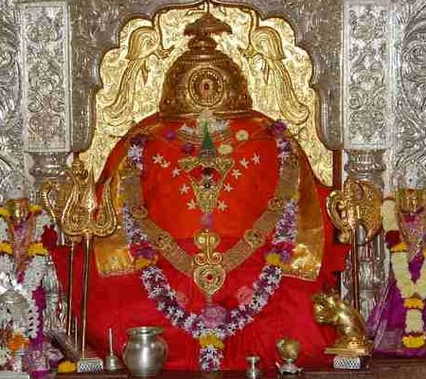EXPLORE ASHTAVINAYAK TOUR
Ashtavinayaka Temples refer to the eight Shrines of Lord Ganesha situated in Maharashtra state of India. The Ashtavinayaka Yatra is the pilgrimage covering these eight holy abodes of Ganesha in and around Pune District of Maharashtra.
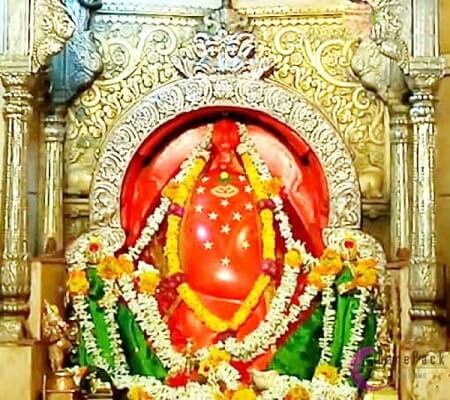
Shri Mayureshwar Temple, Morgaon
Mayureshwar Temple is located in Morgaon village, Pune district, Maharashtra, and holds significant reverence as one of the Ashtavinayak temples dedicated to Lord Ganesha. The temple's history spans back to ancient times, with its present structure evolving over centuries.
According to the Ganesha Purana, Mayureshwar Temple commemorates the spot where Lord Ganesha vanquished the demon Sindhu, who had been tormenting gods and humans. What distinguishes Mayureshwar from other Ashtavinayak temples is its unique depiction of Ganesha seated atop a peacock (Mayureshwar), symbolizing wisdom and intellect.
The temple serves as a crucial pilgrimage site where devotees seek blessings from Lord Ganesha to overcome obstacles and fulfill their desires. It attracts thousands of devotees throughout the year, with particularly heightened fervor during festivals like Ganesh Chaturthi, characterized by elaborate rituals and vibrant celebrations. The tranquil surroundings and deep-rooted historical significance contribute to making Mayureshwar Temple a cultural and spiritual cornerstone within Maharashtra's religious landscape.
Shri Siddhivinayak Temple, Siddhatek
The Siddhivinayak Temple at Siddhatek is located in the Ahmednagar district of Maharashtra, on the banks of the Bhima River.
According to the Mudgala Purana, Lord Vishnu defeated the demons Madhu and Kaitabha after receiving various siddhis (powers) from Lord Ganesha. This place, where Lord Vishnu attained these siddhis, came to be known as Siddhatek, and the Ganesha idol enshrined there became known as Siddhivinayak.
Notably, the idol of Ganesha here has its trunk turned to the right, a unique feature as most Ganesh idols traditionally have their trunks turned to the left. It is believed that this right-trunked form of Ganesha is very powerful yet challenging to please, making it distinctive among the Ashtavinayaka shrines.
The temple, constructed in black stone and facing north, features a garbhagriha (sanctum) that is 15 feet high and 10 feet wide. Inside, the swayambhu idol of Shree Siddhivinayaka is placed within a brass frame, flanked by brass idols of Jay and Vijay on either side.
The temple is revered as a Jagrut (awakened) place of Shree Ganesh, where Siddhivinayak is believed to lead work to the completion.
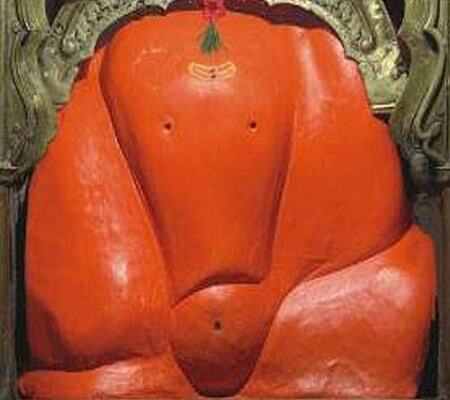
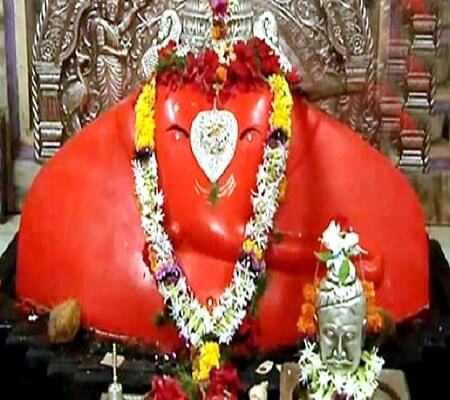
Ballaleshwar Temple, Pali
Ballaleshwar Temple, located in Pali town within Maharashtra's Raigad district. Belonging to the Ashtavinayak circuit, it is dedicated to Lord Ganesha, revered as Ballaleshwar.
Ballaleshwar Temple derives its name from a devotee named Ballala, known for his unwavering devotion to Lord Ganesha.Ballala pleased Lord Ganesha with his sincere prayers and dedication. In return, Lord Ganesha appeared before Ballala and granted him boons, including the fulfillment of his wishes. This event bestowed upon the temple its name, Ballaleshwar, signifying Lord Ganesha as the one who grants the desires of his devotees.
Pali's Ballaleshwar is the only Vinayak dressed as a Brahmin, as vinayaka gave his darshan in the guise of Brahmin. The idol of Lord Ganesha sits on a stone throne facing east, set against a silver background embellished with depictions of Riddhi and Siddhi, who wave chamaras (hand fans). The idol's eyes and navel are adorned with diamonds, enhancing its divine aura and symbolism.
Varadavinayaka Temple, Mahad
Varadavinayaka Temple, located in the village of Mahad within Maharashtra's Raigad district, holds a pivotal place within the Ashtavinayak pilgrimage circuit, comprising eight esteemed temples dedicated to Lord Ganesha.
The temple's main idol, Varada Vinayak, is a swayambu (self-originated) deity. The idol was discovered immersed in an adjacent lake in 1690 AD. Later, in 1725 AD, the temple was constructed under the patronage of Peshwa Sardar Ramji Mahadev Biwalkar, who gifted it to the village.
One of the distinctive aspects of Mahad's Varadavinayaka Temple is the Nandadeep lamp, which has been continuously burning since 1892, spanning over 107 years—a testament to the temple's enduring spiritual significance. The temple complex also houses idols of Mushika (Ganesha's mouse vehicle), Navagraha Devatas (nine planetary deities), and a Shivalinga. Four elephant idols guard the temple's four corners, adding to its sacred ambiance.
Devotees visiting this Ashtavinayak Temple are granted the rare privilege of entering the Garbhagriha to personally pay homage to Lord Ganesha. The temple sees a surge of devotees during Maghi Chaturthi, especially known for its auspicious significance in blessing couples with progeny upon consuming the coconut received as prasad.
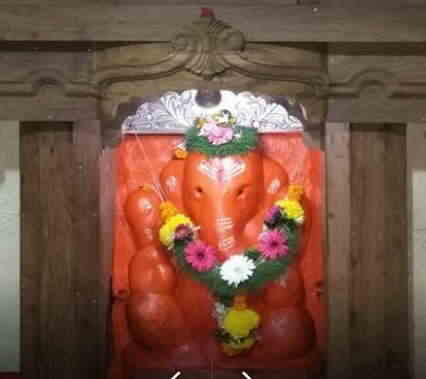
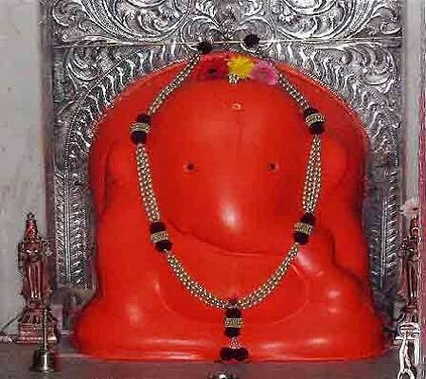
Chintamani Temple, Theur
The Chintamani Temple in Theur, Maharashtra, is dedicated to Lord Ganesha and holds significant reverence as one of the prominent Ashtavinayak temples in the region. The temple is linked to the legend where Lord Ganesha retrieved the Chintamani gem for his devotee, Gritsamada. This gem, believed to fulfill wishes and dispel worries, gives the temple its name "Chintamani," signifying Ganesha's role as a remover of obstacles.
Renowned for its size and popularity among the Ashtavinayak temples, the Chintamani Temple features a central shrine dedicated to Lord Ganesha. Additionally, the temple complex includes several smaller shrines devoted to deities like Mahadeva (Shiva), Vishnu-Lakshmi, and Hanuman, enriching its spiritual ambiance. Inside the temple hall, a notable black stone water fountain adds to its architectural charm.
The idol of Lord Ganesha at the Chintamani Temple is considered self-manifested, a characteristic shared with other Ashtavinayak icons. Hardly any features are visible except the head adorned with jewel eyes and a trunk turning to his left. Lord Ganesha is interpreted to be seated in a cross-legged posture, embodying wisdom and prosperity. Devotees visit the Chintamani Temple throughout the year, particularly during festivals and auspicious occasions, seeking blessings and divine intervention in their lives.
Girijatmaj Ganpati Temple, Lenyadri
The Girijatmaj Ganpati Temple is located in Lenyadri, Maharashtra, India, positioned atop a hill near Junnar town, approximately 90 kilometers from Pune. Accessing the temple involves climbing 283 steps painstakingly carved into the rocky terrain, which enhances the pilgrimage experience, imbuing the journey with a sense of spiritual significance and adventure. Within Cave 7, known as Girijatmaj Cave, resides the revered idol of Lord Ganesha, making the temple a focal point of worship and devotion.
Girijatmaj Ganpati Temple is linked with the story of Goddess Parvati (Girija) undertaking rigorous penance to have Lord Ganesha as her son. Impressed by her unwavering devotion, Lord Ganesha agreed to be born as her son, earning the name "Girijatmaj," which underscores his maternal bond with Goddess Parvati.
The idol of Lord Ganesha at Girijatmaj Ganpati Temple is uniquely depicted alongside his consorts Riddhi and Siddhi, representing prosperity and spiritual attainment. Carved directly into the rock of the cave, the idol is revered as a Swayambhu murti, emphasizing its natural and ancient origins. The serene surroundings of the temple complex provide a conducive environment for prayer, meditation, and spiritual contemplation, attracting devotees who seek blessings from Lord Ganesha for wisdom, success, and the removal of obstacles in their lives.
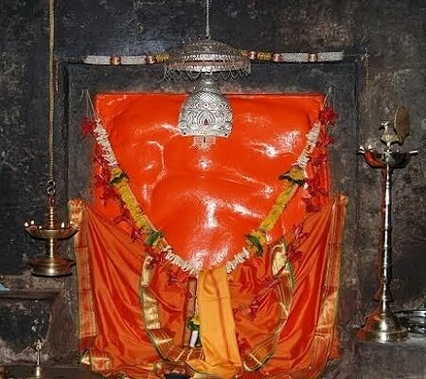
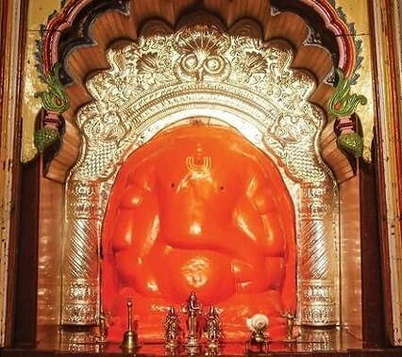
Vighneshwara Temple, Ozar
The Vighneshwara Temple stands majestically on the banks of the river Kukadi, distinguished among the Ashtavinayak Kshetras for its unique architectural features including a golden dome and pinnacle. Dedicated to Lord Ganesha, the temple is revered under various names such as Vigneshwara, Vigneshvar, or Vigneshwar, all of which signify his role as the "Lord of obstacles" (Vighneshwara) and the "Remover of obstacles" (Vignahar or Vignahara). This divine aspect of Ganesha is rooted in legend of his triumph over Vignasura, the embodiment of obstacles and challenges.
The idol of Vighneshwar Vinayak within the temple faces eastward, with its trunk elegantly turned towards the left. Adorned in vermilion mixed with oil, the idol features intricate details such as two emerald-studded eyes, and a diamond embedded on the forehead and navel, symbolizing divine grace and auspiciousness. Flanking the main idol are brass statues of Riddhi and Siddhi, representing prosperity and spiritual attainment respectively, further enhancing the spiritual ambiance of the sanctum.
Devotees visit the Vighneshwara Temple to seek blessings from Lord Ganesha for the removal of obstacles in their endeavors and for success in their undertakings. The temple's serene location by the river adds to its allure, providing a peaceful setting for prayer and meditation amidst the blessings of the revered deity.
Mahaganpati Temple, Ranjangaon
The Ranjangaon Ganpati temple, also known as Mahaganpati of Ranjangaon, is situated in Shirur Taluka, approximately 51.5 km from Pune via the Pune - Ahmednagar Highway, making it easily accessible within about an hour and thirty-one minutes.
Facing east, the temple features a grand entrance gate adorned with intricate designs and flanked by idols of two doorkeepers Jay and Vijay.The temple is uniquely constructed so that sunlight falls directly on the idol of Lord Ganesha, enhancing its divine presence and significance.
The idol worshipped at Ranjangaon is Mahaganpati, revered as the most powerful representation of Lord Ganesha. Mahaganpati is depicted seated on a lotus throne, accompanied by his consorts Siddhi (symbolizing spiritual power) and Riddhi (representing prosperity). Known also as 'Mahotkat', the idol is believed to possess ten trunks and twenty hands, embodying Lord Ganesha's divine attributes and omnipotence.
Lord Shiva invoked this formidable form of Ganesha to defeat the demon Tripurasura, hence earning the epithet Tripurarivade Mahaganpati. The name Ranjangaon derives from the word 'Ranjan', meaning the delighted one, signifying the joy brought by Lord Ganesha's victory over obstacles at this sacred place, formerly known as Manipur.
